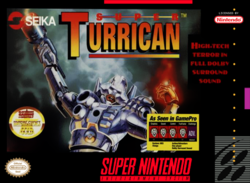| Super Turrican | |
|---|---|
 North American cover art | |
| Developer | Factor 5 |
| Publishers |
|
| Producer | Julian Eggebrecht |
| Designers | Julian Eggebrecht, Holger Schmidt, Frank Matzke |
| Artists | Frank Matzke, Ramiro Vaca, Andreas Escher |
| Composer | Chris Huelsbeck |
| Series | Turrican |
| Platform | Super NES |
| Release | Super NES Director's Cut
|
| Genre | Run and gun |
| Mode | Single-player |
Super Turrican is a run and gun video game and the fifth game in the Turrican series. It was released for the Super Nintendo Entertainment System in 1993. [1]